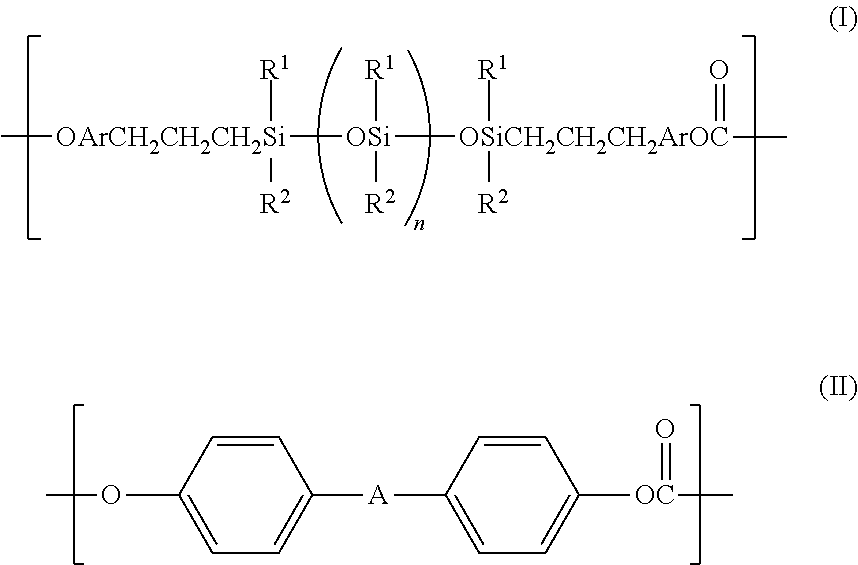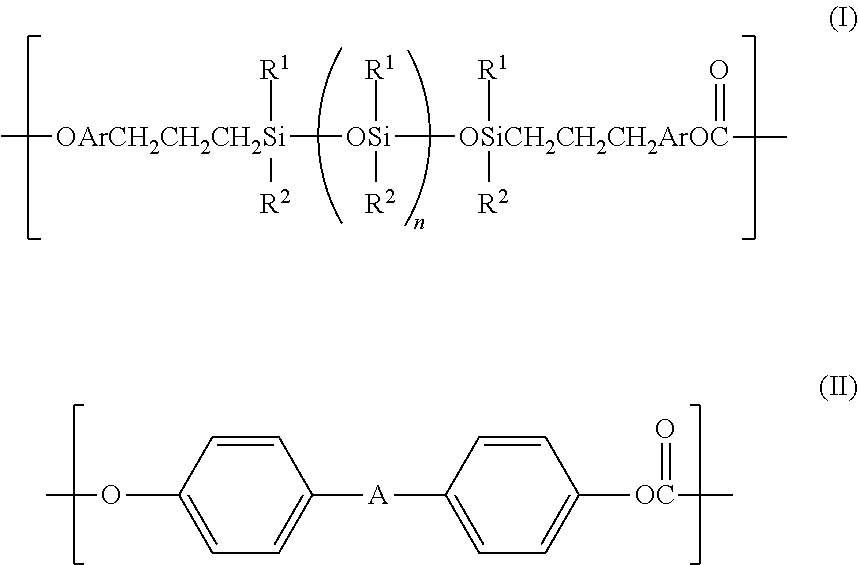Polycarbonate and polysiloxane block copolymer and flame retardant resin composition
a polysiloxane block and resin technology, applied in the field of polysiloxane block copolymer, can solve the problems of insufficient flame retardance and undesirable methods, and achieve the effects of reducing the cost of production, and improving the strength and transparency of the flame retardant resin composition
- Summary
- Abstract
- Description
- Claims
- Application Information
AI Technical Summary
Benefits of technology
Problems solved by technology
Method used
Image
Examples
preparation example 1-1
[0069]After a material represented by the following formula (VI) (46.2 g),
octamethylcyclotetrasiloxane (296 g) and 1,3,5,7-tetravinyl-1,3,5,7-tetramethylcyclotetrasiloxane (40.5 g) were equally mixed, trifluoromethanesulfonic acid (3.8 g) was added thereto at 25° C. and the product was equally agitated at 25 to 35° C. for 15 hours. Afterward, sodium carbonate (20 g) was added thereto for neutralization for one hour, and unreacted compounds were removed by distillation under reduced pressure at 120° C. after filtration to obtain a desired product represented by the following formula (VII).
preparation example 1-2
[0070]After a material represented by the above formula (VI) (46.2 g), octamethylcyclotetrasiloxane (261 g) and 1,3,5,7-tetravinyl-1,3,5,7-tetramethylcyclotetrasiloxane (80.9 g) were equally mixed, trifluoromethanesulfonic acid (3.9 g) was added thereto at 25° C. and equally agitated at 25 to 35° C. for 15 hours. Afterward, sodium carbonate (20 g) was added thereto for neutralization for one hour, and unreacted compounds were removed by distillation under reduced pressure at 120° C. after filtration to obtain a desired product represented by the following formula (VIII).
preparation example 2-1
[0071]907 parts by mass of bisphenol A, 60 parts by mass of polysiloxane obtained in Preparation example 1-1, triethylamine (10 ml), 14 parts by mass of phenol and 1.5 parts by mass of sodium gluconate were mixed in 2 parts by mass of water and dichloromethane (2.5 L). The two-phase mixture was strongly agitated, and 50% sodium hydroxide solution was added thereto to adjust pH to 10. While the pH was maintained from 10.0 to 10.5, 453 parts by mass of phosgene was added thereto, and a reaction mixture was purged with nitrogen, thereby adding dichloromethane (2 L) thereto to separate an organic phase from a salt-water phase.
[0072]The organic phase washed with a 1% hydrochloric acid solution and a polycarbonate and polysiloxane copolymer dissolved in a dichloromethane solution were precipitated with steam to isolate a siloxane and polycarbonate block copolymer [PC-1] as a white resin. By drying the product, 950 parts by mass of a copolymer PC-1 was obtained.
[0073]The polysiloxane conte...
PUM
| Property | Measurement | Unit |
|---|---|---|
| melt flow rate | aaaaa | aaaaa |
| melt flow rate | aaaaa | aaaaa |
| diameter | aaaaa | aaaaa |
Abstract
Description
Claims
Application Information
 Login to View More
Login to View More - R&D
- Intellectual Property
- Life Sciences
- Materials
- Tech Scout
- Unparalleled Data Quality
- Higher Quality Content
- 60% Fewer Hallucinations
Browse by: Latest US Patents, China's latest patents, Technical Efficacy Thesaurus, Application Domain, Technology Topic, Popular Technical Reports.
© 2025 PatSnap. All rights reserved.Legal|Privacy policy|Modern Slavery Act Transparency Statement|Sitemap|About US| Contact US: help@patsnap.com



